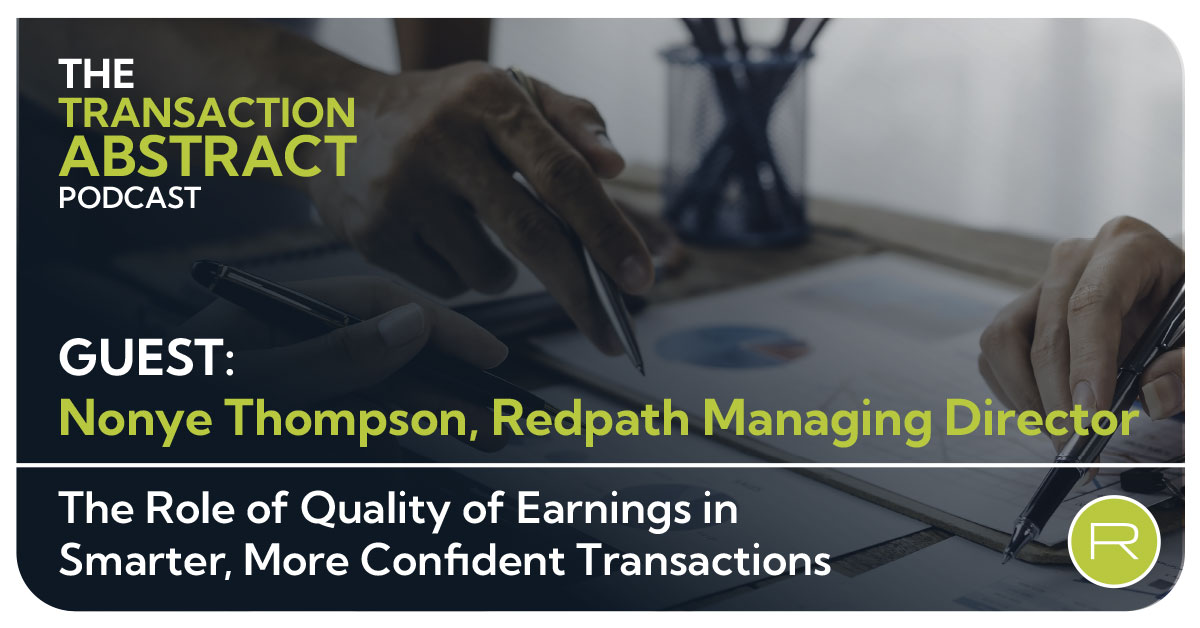The Role of Quality of Earnings in Smarter, More Confident Transactions
In this episode of The Transaction Abstract Podcast, Joe Hellman sits down with Nonye Thompson, Managing Director in Redpath’s Transaction Advisory...
3 min read
 Redpath and Company
:
Nov 4, 2021
Redpath and Company
:
Nov 4, 2021
![What is the Difference Between SBA and Conventional Financing? [PODCAST]](https://www.redpathcpas.com/hubfs/AdobeStock_223963683_adobespark.jpeg)
The Small Business Administration (SBA) is a federal agency that offers a variety of funding programs. In a recent episode of The Transaction Abstract, Joe Hellman spoke with Adam Webb, Managing Director of Quazar Business Brokerage, to explain differences between conventional financing and SBA financing for acquisitions.
Quazar Business Brokerage focuses on helping people buy and sell businesses valued from $1 million to $10 million. Its sister company, Quasar Capital, is an investment bank specializing in purchases of $10 million to $100 million, representing a typical EBITDA of $2 million to $10 million.
The Small Business Administration has two programs pertinent to small business M&A, the 7A Program and the 504 Program. The 504 Loan Program is for buying real estate and other capital assets. The 7A is the right option for most small businesses to fund strategic transactions.
Under any SBA loan program, you do not receive money from the government. Instead, the agency guarantees part of your loan in the event of default. This makes the program attractive to lenders, who need not absorb as much risk to extend a funding package.
The SBA guarantees 75% of a standard 7A loan, but that includes a funding fee, which can range from 2.0-3.5%. That can be a pretty substantial fee when you are contemplating a $5 million dollar loan.
SBA 7A loans are cash flow based; even if you do not have many assets, you can still be approved if you have strong cash flow. The total loan value is capped at $5 million. Some larger buyers may never have heard of it, but it can be valuable in many different situations.
In smaller transactions, company valuation is often driven by how much someone can borrow. The SBA 7A Loan Program enables higher levels of borrowing, especially since loans can be on a ten-year amortization schedule compared to five or seven years for conventional financing. Sellers like this because it generally facilitates a higher valuation for their company.
During the SBA 7A loan process, the bank will order a business valuation that must meet or exceed the amount of the loan – similar to how a home’s valuation must match its loan package before funds will be issued. This is not usually an issue, as the initial lending decision is based on cash flow, and the valuation is usually aligned with that figure. This eases complications for both buyers and sellers.
Borrowers do not have full discretion to do whatever they want with 7A loan money. Regulations establish “hoops” they must clear, with some transactions more complex than others. In particular, it is useful to look for banks with special status from the SBA who can do all of the origination work in-house.
Banks without this status must send off the prospective loan package for SBA review.
The SBA has several lending guidelines that influence whether the 7A Loan Program is right for any given transaction. For example, the agreement cannot have an earn-out component where the seller “earns” a part of the purchase price based on the company’s performance after the deal closes.
That restricts the options for risk-sharing you might otherwise include in a deal’s structure.
If a bank is not a preferred SBA lender, the extra layer of scrutiny can add several weeks to the approval timeline. Generally speaking, the Small Business Administration “likes to ask questions.” If they manually review an application package, they are likely to request verification of details the bank would not.
As a rule, Adam shared, the “hoops” are not significant relative to the merits of the 7A Program.
7A is great for buyers seeking to buy a business under $5 million. This equips them to buy a business with 10-15% cash, since equity banks are comfortable lending 75% and sellers often carry a note for about 10%. That represents a typical SBA 7A loan structure and offers good leverage relative to a conventional loan.
Conventional financing is when the bank lends directly, usually on a senior basis – meaning they have first lien on the business assets in the event of a liquidation. These loans are rarely fully secured by business assets, so the bank must take on risk. Banks issue funding faster and can deal with different structures, but the amortization timeline tends to be shorter. That restricts borrowing and, thus, valuations.
Adam suggested that, without the SBA 7A program, valuations on sub-$5 million businesses would be lower than they are today. He advised potential buyers to talk to a lender who understands both programs — an SBA preferred lender also knowledgeable and experienced with conventional financing.

In this episode of The Transaction Abstract Podcast, Joe Hellman sits down with Nonye Thompson, Managing Director in Redpath’s Transaction Advisory...

In this episode of The Transaction Abstract Podcast, Joe Hellman sits down with Dan Hennessey, the newly appointed CEO of Sam Schwartz Pedestrian...
![Common Legal Pitfalls in M&A Transactions with Kim Lowe [PODCAST]](https://www.redpathcpas.com/hubfs/Podcast-Legal-Pitfalls-Kim-Lowe.jpg)
In this episode of The Transaction Abstract Podcast, Joe Hellman sits down with Kim Lowe, Partner at Avisen Legal, to discuss the most common legal...